Hyderabad: Consumption and investment, the two factors which influenced the economy are on a slowdown. Private equity which was at 66.2 per cent during 2012-14 fell to 57.5 during 2015-19. Investment rate fell to 32.3 per cent and growth rate fell to its lowest in 6 years. These numbers are a reflection of the upcoming crisis. Economic inequality, lack of basic infrastructure and a weak rural economy are the reasons.
The central government has introduced various schemes to strengthen the economy during such dire times. It announced incentives to encourage investments. Some of the incentives are the slashing of corporate tax to 22 per cent from the previous 30 per cent, increasing loans for constructions. The move to increase funds to housing finance companies to Rs 30,000 crore, is an important move.
In the budget session, it has been revealed that Rs. 100 lakh crore will be invested in basic infrastructure industry. The actual amount invested in each project will be decided by an expert committee appointed by the central finance ministry. There is no doubt that such huge investment will influence the infra industry. It will create returns on these investments and strengthen the economy. As a result, liquidity will increase. In order to achieve a laudable GDP and maintain it consistently, schemes must be implemented effectively instead of confining them to papers.
A nation’s human resource and economic development are interlinked with the progress it achieved in social and functional infrastructure creation. If the quality infrastructure is important for domestic product, societal infrastructure is important for human resource and economic development.
Quality education and healthy living conditions only can guarantee development in human resources. Though many organizations urged the governments to invest at least 6 per cent of the budget in education, the percentage is limited to 4.6. This is less than the international average. While India is spending only 1.5 per cent of the total GDP on healthcare, the US spends about 18 per cent.
As a result, Indians are forced to spend more on education and healthcare. After the 1991 economic reforms, financial inequalities have cropped up in the nation. In rural and urban areas, there was reported to be an uncommon rise in inequality index from 1993-94. In 2017, the richest 1 per cent owned 73 per cent of the wealth. There was only 1 per cent rise in the income of 67 per cent population.
Read more:Mutually advantageous if tread as one
According to the Global Competitiveness Index (2018), India stood 58th among the 140 surveyed countries. China, ranked at 28th is the best performer among the BRICS nations. India is spending less on basic infrastructure and amenities. By March 2019, India invested only 29.8 per cent of its GDP on infrastructure creation, which is less than the 15-year average.
Development of infrastructure directly boosts industries like iron, cement, steel, real estate and automobiles. There is a 4-5 per cent deficit in GDP in the field of infrastructure. If this deficit is overcome, economic growth can be accelerated. Then 1 per cent spend towards infrastructure can lead to a 2 per cent growth in GDP. When compared to global economies, India’s infrastructure is substandard.
